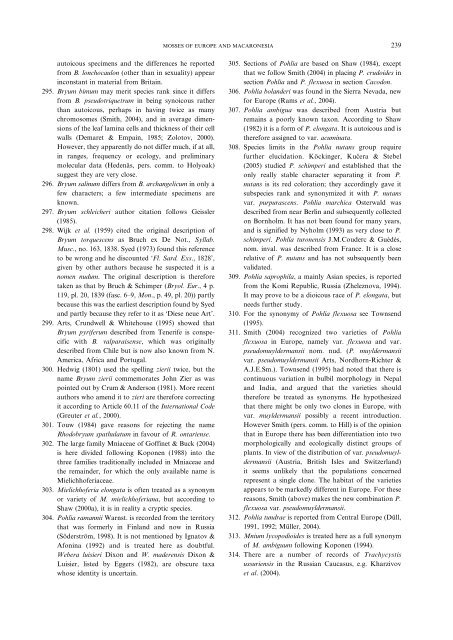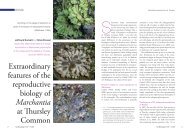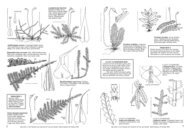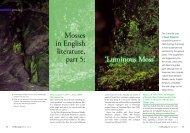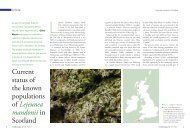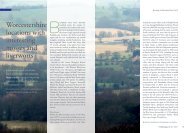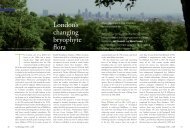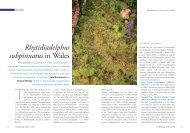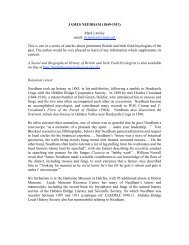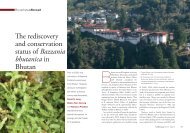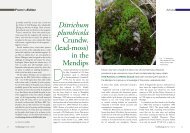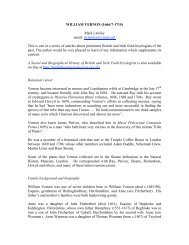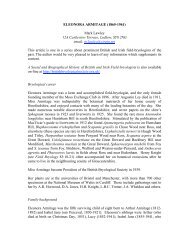Bryological Monograph An annotated checklist of the mosses of ...
Bryological Monograph An annotated checklist of the mosses of ...
Bryological Monograph An annotated checklist of the mosses of ...
You also want an ePaper? Increase the reach of your titles
YUMPU automatically turns print PDFs into web optimized ePapers that Google loves.
autoicous specimens and <strong>the</strong> differences he reported<br />
from B. lonchocaulon (o<strong>the</strong>r than in sexuality) appear<br />
inconstant in material from Britain.<br />
295. Bryum bimum may merit species rank since it differs<br />
from B. pseudotriquetrum in being synoicous ra<strong>the</strong>r<br />
than autoicous, perhaps in having twice as many<br />
chromosomes (Smith, 2004), and in average dimensions<br />
<strong>of</strong> <strong>the</strong> leaf lamina cells and thickness <strong>of</strong> <strong>the</strong>ir cell<br />
walls (Demaret & Empain, 1985; Zolotov, 2000).<br />
However, <strong>the</strong>y apparently do not differ much, if at all,<br />
in ranges, frequency or ecology, and preliminary<br />
molecular data (Hedenäs, pers. comm. to Holyoak)<br />
suggest <strong>the</strong>y are very close.<br />
296. Bryum salinum differs from B. archangelicum in only a<br />
few characters; a few intermediate specimens are<br />
known.<br />
297. Bryum schleicheri author citation follows Geissler<br />
(1985).<br />
298. Wijk et al. (1959) cited <strong>the</strong> original description <strong>of</strong><br />
Bryum torquescens as Bruch ex De Not., Syllab.<br />
Musc., no. 163, 1838. Syed (1973) found this reference<br />
to be wrong and he discounted ‘Fl. Sard. Exs., 1828’,<br />
given by o<strong>the</strong>r authors because he suspected it is a<br />
nomen nudum. The original description is <strong>the</strong>refore<br />
taken as that by Bruch & Schimper (Bryol. Eur., 4 p.<br />
119, pl. 20, 1839 (fasc. 6–9, Mon., p. 49, pl. 20)) partly<br />
because this was <strong>the</strong> earliest description found by Syed<br />
and partly because <strong>the</strong>y refer to it as ‘Diese neue Art’.<br />
299. Arts, Crundwell & Whitehouse (1995) showed that<br />
Bryum pyriferum described from Tenerife is conspecific<br />
with B. valparaisense, which was originally<br />
described from Chile but is now also known from N.<br />
America, Africa and Portugal.<br />
300. Hedwig (1801) used <strong>the</strong> spelling zierii twice, but <strong>the</strong><br />
name Bryum zierii commemorates John Zier as was<br />
pointed out by Crum & <strong>An</strong>derson (1981). More recent<br />
authors who amend it to zieri are <strong>the</strong>refore correcting<br />
it according to Article 60.11 <strong>of</strong> <strong>the</strong> International Code<br />
(Greuter et al., 2000).<br />
301. Touw (1984) gave reasons for rejecting <strong>the</strong> name<br />
Rhodobryum spathulatum in favour <strong>of</strong> R. ontariense.<br />
302. The large family Mniaceae <strong>of</strong> G<strong>of</strong>finet & Buck (2004)<br />
is here divided following Koponen (1988) into <strong>the</strong><br />
three families traditionally included in Mniaceae and<br />
<strong>the</strong> remainder, for which <strong>the</strong> only available name is<br />
Mielichh<strong>of</strong>eriaceae.<br />
303. Mielichh<strong>of</strong>eria elongata is <strong>of</strong>ten treated as a synonym<br />
or variety <strong>of</strong> M. mielichh<strong>of</strong>eriana, but according to<br />
Shaw (2000a), it is in reality a cryptic species.<br />
304. Pohlia ramannii Warnst. is recorded from <strong>the</strong> territory<br />
that was formerly in Finland and now in Russia<br />
(Söderström, 1998). It is not mentioned by Ignatov &<br />
Afonina (1992) and is treated here as doubtful.<br />
Webera luisieri Dixon and W. maderensis Dixon &<br />
Luisier, listed by Eggers (1982), are obscure taxa<br />
whose identity is uncertain.<br />
MOSSES OF EUROPE AND MACARONESIA 239<br />
305. Sections <strong>of</strong> Pohlia are based on Shaw (1984), except<br />
that we follow Smith (2004) in placing P. crudoides in<br />
section Pohlia and P. flexuosa in section Cacodon.<br />
306. Pohlia bolanderi was found in <strong>the</strong> Sierra Nevada, new<br />
for Europe (Rams et al., 2004).<br />
307. Pohlia ambigua was described from Austria but<br />
remains a poorly known taxon. According to Shaw<br />
(1982) it is a form <strong>of</strong> P. elongata. It is autoicous and is<br />
<strong>the</strong>refore assigned to var. acuminata.<br />
308. Species limits in <strong>the</strong> Pohlia nutans group require<br />
fur<strong>the</strong>r elucidation. Köckinger, Kučera & Stebel<br />
(2005) studied P. schimperi and established that <strong>the</strong><br />
only really stable character separating it from P.<br />
nutans is its red coloration; <strong>the</strong>y accordingly gave it<br />
subspecies rank and synonymized it with P. nutans<br />
var. purpurascens. Pohlia marchica Osterwald was<br />
described from near Berlin and subsequently collected<br />
on Bornholm. It has not been found for many years,<br />
and is signified by Nyholm (1993) as very close to P.<br />
schimperi. Pohlia turonensis J.M.Couderc & Guédès,<br />
nom. inval. was described from France. It is a close<br />
relative <strong>of</strong> P. nutans and has not subsequently been<br />
validated.<br />
309. Pohlia saprophila, a mainly Asian species, is reported<br />
from <strong>the</strong> Komi Republic, Russia (Zheleznova, 1994).<br />
It may prove to be a dioicous race <strong>of</strong> P. elongata, but<br />
needs fur<strong>the</strong>r study.<br />
310. For <strong>the</strong> synonymy <strong>of</strong> Pohlia flexuosa see Townsend<br />
(1995).<br />
311. Smith (2004) recognized two varieties <strong>of</strong> Pohlia<br />
flexuosa in Europe, namely var. flexuosa and var.<br />
pseudomuyldermansii nom. nud. (P. muyldermansii<br />
var. pseudomuyldermansii Arts, Nordhorn-Richter &<br />
A.J.E.Sm.). Townsend (1995) had noted that <strong>the</strong>re is<br />
continuous variation in bulbil morphology in Nepal<br />
and India, and argued that <strong>the</strong> varieties should<br />
<strong>the</strong>refore be treated as synonyms. He hypo<strong>the</strong>sized<br />
that <strong>the</strong>re might be only two clones in Europe, with<br />
var. muyldermansii possibly a recent introduction.<br />
However Smith (pers. comm. to Hill) is <strong>of</strong> <strong>the</strong> opinion<br />
that in Europe <strong>the</strong>re has been differentiation into two<br />
morphologically and ecologically distinct groups <strong>of</strong><br />
plants. In view <strong>of</strong> <strong>the</strong> distribution <strong>of</strong> var. pseudomuyldermansii<br />
(Austria, British Isles and Switzerland)<br />
it seems unlikely that <strong>the</strong> populations concerned<br />
represent a single clone. The habitat <strong>of</strong> <strong>the</strong> varieties<br />
appears to be markedly different in Europe. For <strong>the</strong>se<br />
reasons, Smith (above) makes <strong>the</strong> new combination P.<br />
flexuosa var. pseudomuyldermansii.<br />
312. Pohlia tundrae is reported from Central Europe (Düll,<br />
1991, 1992; Müller, 2004).<br />
313. Mnium lycopodioides is treated here as a full synonym<br />
<strong>of</strong> M. ambiguum following Koponen (1994).<br />
314. There are a number <strong>of</strong> records <strong>of</strong> Trachycystis<br />
ussuriensis in <strong>the</strong> Russian Caucasus, e.g. Kharzivov<br />
et al. (2004).


